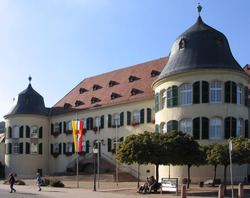Time zone CET/CEST (UTC+1/+2) Area 10.71 km² Local time Monday 11:51 PM Dialling code 06343 | Municipal assoc. Bad Bergzabern Postal codes 76887 Population 7,763 (31 Dec 2008) Postal code 76887 | |
 | ||
Weather 7°C, Wind SW at 31 km/h, 90% Humidity Points of interest Westwallmuseum Bad Bergzabern, Museum der Stadt Bad Bergzabern, Bad Bergzabern | ||
Pfalz bad bergzabern
Bad Bergzabern ( listen ) is a municipality in the Südliche Weinstraße district, on the German Wine Route in Rhineland-Palatinate, Germany. It is situated near the border with France, on the south-eastern edge of the Palatinate forest, approximately 15 kilometres (9.3 mi) southwest of Landau.
Contents
- Pfalz bad bergzabern
- Map of Bad Bergzabern Germany
- Bad bergzabern sehensw rdigkeiten
- History
- Population development
- Sons and daughters of the town
- References
Map of Bad Bergzabern, Germany
Bad Bergzabern is the seat of the Verbandsgemeinde ("collective municipality") Bad Bergzabern.
Bad Bergzabern has a tradition as a holiday destination and contains various half-timbered houses from the seventeenth and eighteenth centuries. Of particular note from an earlier century is the Gasthaus Zum Engel (1579), which has been described as the most beautiful renaissance building in the entire region.
Bad bergzabern sehensw rdigkeiten
History
In the sixteenth century local scholars were keen to assert that the town had been founded under the Romans, and sources from this period refer to the medieval Latin name as "Tabernae Montanus". Although the area was indeed under the control of the Roman empire two thousand years ago, evidence does not support the notion that Bad Bergzabern had its own origins so far back.
In 1676, during the Franco-Dutch War, the French under Louis XIV infamously laid waste the Palatinate region as part of a scheme to enlarge France. Much of Bad Bergzabern was destroyed in the process. One of the few buildings that did survive the French king's torching of the town was the local duke's administrative office, which later became the Gasthaus zum Engel.
Reconstruction began in the eighteenth century under Gustav, Duke of Zweibrücken. The work involved stone buildings in the newly fashionable baroque style and included a residential Schloss for the duke. The project was directed by the architect Jonas Erikson Sundahl (1678-1762) who shared the duke's own Swedish provenance.
Friedrich Julius Marx, wrote a short history of Bergzabern „Oratio de Tabernis Montanis“ (Zweibrücken 1730).
The overlordship of the dukes of Duke of Zweibrücken ended with the French Revolution. On 10 November 1792 the townsfolk applied for incorporation within the new French Republic. A generation later former French frontiers were restored after the fall of Napoleon, however, and under the terms of the Second Peace of Paris (10 November 1815) the whole region came under the control of the Wittelsbach kings of Bavaria.
Population development
1871-1987: Census results:
